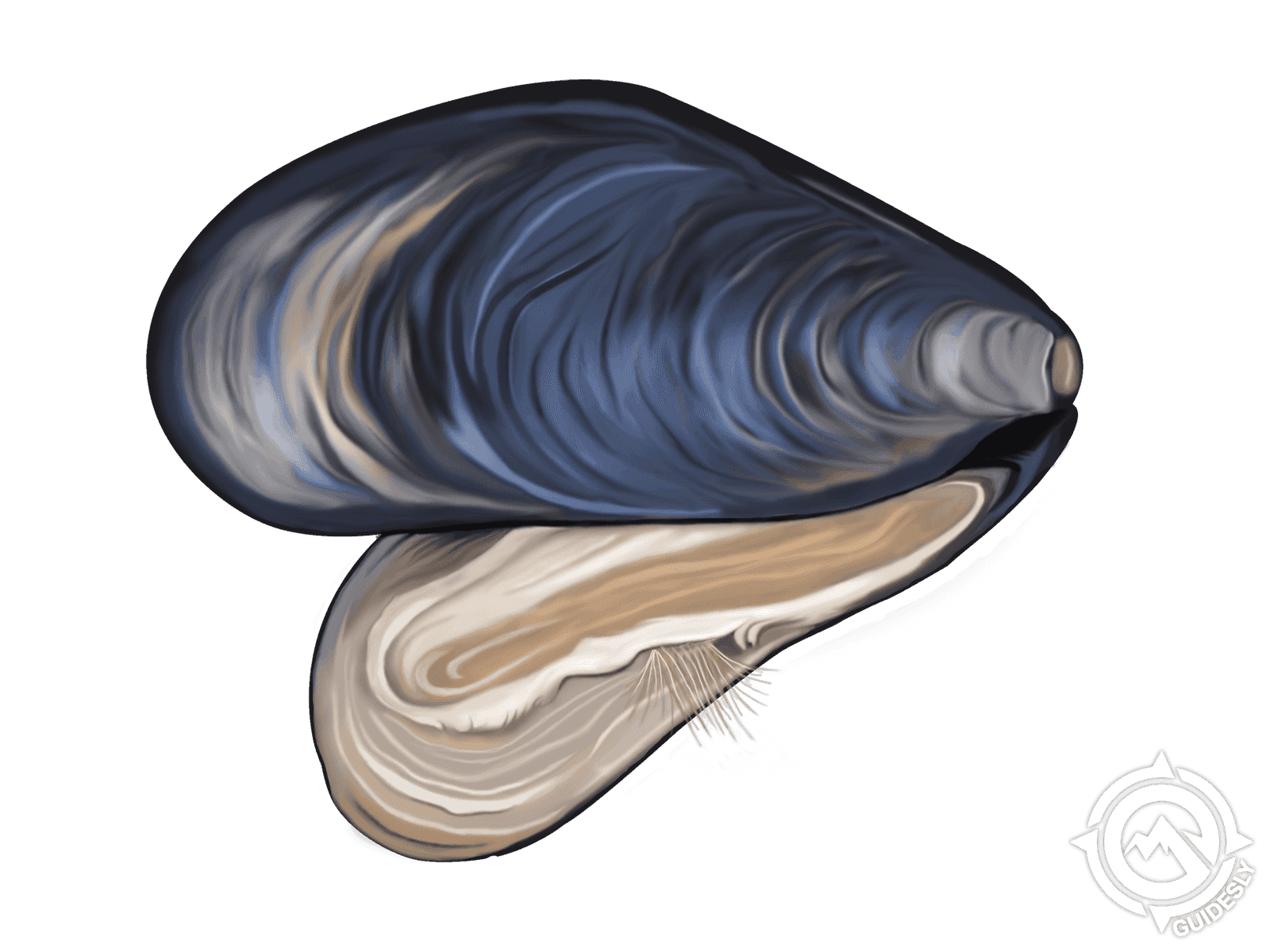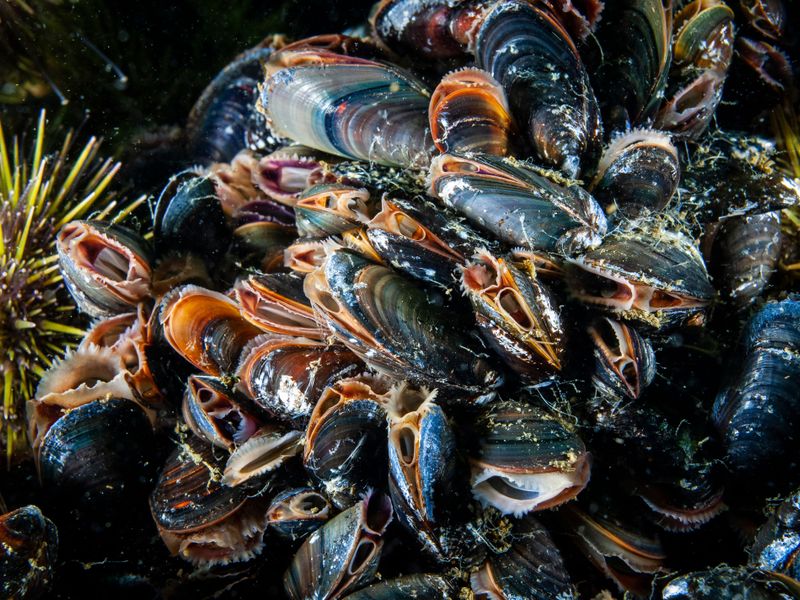Blue Mussels

Species Details
Mytilus Edulis
Mytilidae
Mytilida
Coastal ocean, Estuaries, Seagrass beds, Subtidal zones, Deeper waters
0 - 0 lbs.
2" - 4"
What Makes Blue Mussels' Shell's Blue?
The color of blue mussels comes from pigments in their shells, specifically a combination of proteins & carotenoids, like mytilusins, a type of protein that contributes to the shell's color. Carotenoid pigments like astaxanthin, responsible for the pinkish or red hues, can influence the blue or purplish tint of the shell.
Blue Mussels are a fascinating species of bivalve mollusks. Known for their distinctive blue-black shells, they inhabit coastal waters around the world.
These creatures play a crucial role in marine ecosystems. As filter feeders, they consume plankton and other small particles, purifying the water in the process.
Understanding Blue Mussels
Blue Mussels, scientifically named Mytilus edulis, thrive in coastal waters. They are often found attached to rocks, piers, and other substrates.
These mussels are not just pretty to look at. They are also great purifiers. Their filter-feeding behavior helps maintain clean water.
Blue Mussels boast remarkable adaptability. They flourish in a wide range of salinities and temperatures.
Here are some key features of Blue Mussels:
Distinctive blue-black shells
Filter feeders, purifying water
Adaptable to different environments
Their prevalence in various cuisines speaks volumes about their culinary value. Wild and farmed varieties are both popular.
Habitat and Distribution of Blue Mussels
The habitat and distribution of Blue Mussels are diverse and extensive. They can be found in intertidal and subtidal zones.
Blue Mussels thrive in the North Atlantic and North Pacific Oceans, playing a vital role in these ecosystems. Their ability to attach to hard surfaces allows them to colonize a variety of areas, including rocky coasts and man-made structures.
Climate change and pollution pose risks to their habitats. These factors can influence their distribution and abundance. Blue Mussels demonstrate resilience by tolerating different salinities, yet environmental threats remain challenging. Conservation efforts focus on protecting mussel beds and maintaining their environment.
Their role as bioindicators highlights their environmental importance. They reflect the health of marine ecosystems. Overall, their presence is integral to the ecological balance.

Diet of Blue Mussels
The diet of Blue Mussels primarily consists of plankton and small organic particles. As filter feeders, they play a crucial role in ecosystems.
They draw water in, trapping food particles using their gills. This process supports marine food chains.
Here's a snapshot of the Blue Mussel diet:
Plankton and phytoplankton
Small organic debris
Microscopic algae and bacteria
Their diet greatly influences their nutritional profile. This benefits both the environment and humans who consume them. These mussels gain essential nutrients from their varied diet, enhancing their taste and health benefits.
Blue Mussels vs Green Mussels
Blue Mussels and Green Mussels are two well-known mussel species. Both are popular in the culinary world.
Despite this, they differ in various aspects. Their habitats, colors, and culinary uses set them apart.
Green Mussels, or Perna canaliculus, hail from New Zealand. They feature a distinctive greenish-brown shell.
In contrast, Blue Mussels are commonly found in the North Atlantic and North Pacific. They are known for their darker, blue-black shells.
Culinary preferences also differ. Blue Mussels are often favored for their sweet flavor and tender texture. Meanwhile, Green Mussels are larger but less tender. Their size makes them suitable for different culinary styles.
Physical Differences
Blue Mussels have shorter, darker shells compared to Green Mussels. Green Mussels are typically larger with a greenish hue.
These physical traits make it easy to distinguish between the two species in seafood markets and recipes.
Taste and Culinary Uses
Blue Mussels are celebrated for their sweet, delicate flavor. Their tender meat is a favorite in European and North American cuisines. Cooks often steam or boil them to enhance their natural taste. They pair well with garlic, white wine, and fresh herbs.
In contrast, Green Mussels boast a more robust texture. They suit heavier recipes, such as curries and stews. Both mussel types offer versatility and can be incorporated into diverse dishes. Their unique tastes and textures make them suitable for a variety of culinary applications.
Can You Eat Blue Mussels?
Yes, you can eat Blue Mussels, and they are indeed a delicious seafood choice. Before consuming, however, it's important to ensure they're fresh. Fresh mussels should be alive with tightly closed shells. Discard any with broken or open shells that do not close when tapped.
It's essential to cook Blue Mussels properly. This reduces any risk of foodborne illnesses. Thorough cooking also enhances their natural flavor. Additionally, check local shellfish advisories before harvesting. This ensures you avoid consuming contaminated mussels.

Health Benefits and Nutritional Value
Blue Mussels are nutrient-rich, providing numerous health benefits. They are high in protein and low in fat, making them a lean seafood option. They also contain omega-3 fatty acids, crucial for heart health. Their high vitamin B12 content supports nerve function and energy production.
Besides vitamins, mussels are rich in essential minerals. These include iron, manganese, and selenium. These nutrients are important for maintaining a balanced diet. Including Blue Mussels in your meals can contribute to a heart-healthy eating plan.
Preparing and Cooking Blue Mussels
Preparing Blue Mussels begins with cleaning them thoroughly. Rinse under cold water and remove the "beard" or byssus. Make sure to discard any damaged or dead ones as well. It's crucial to use fresh mussels for the best flavor and safety.
Cooking methods vary: steaming, boiling, or even baking are popular. Steamed with white wine and garlic can highlight their natural taste. Cooking them until the shells open ensures they're ready to enjoy. Combine them with fresh herbs for added flavor.
Mussels pair well with a range of ingredients, offering culinary versatility. Whether in a classic moules-frites or a seafood chowder, Blue Mussels impress. Exploring different preparations can lead to delightful culinary experiences.
Sustainability and Environmental Impact
Blue Mussels are recognized as a sustainable seafood choice, owing to their minimal environmental impact. They are efficient at reproducing naturally, ensuring stable population levels. This makes their farming and harvesting practices less harmful to the ecosystem.
Their role in the marine environment is significant. Blue Mussels act as natural filters, purifying water by feeding on plankton. This cleansing ability contributes to healthier aquatic habitats. However, careful monitoring is necessary to prevent overharvesting and maintain ecological balance.
The health of Blue Mussel populations can be affected by climate change and pollution. These factors may alter their distribution and impact marine ecosystems. Therefore, sustainable practices in both aquaculture and wild harvesting are essential to protecting these vital resources.
Aquaculture and Wild Harvesting
Aquaculture involves farming Blue Mussels in controlled environments. This method reduces pressure on wild populations. It utilizes ropes or mesh socks for mussels to grow on, ensuring sustainable yields.
Wild harvesting, though traditional, needs careful management. Regulations ensure that wild populations remain viable for future generations. Both methods, done responsibly, help maintain ecological equilibrium.
Conclusion: The Importance of Blue Mussels
Blue Mussels play a crucial role in marine ecosystems and human diets. They provide numerous environmental benefits while offering a nutritious seafood option. Understanding and promoting sustainable practices ensure that Blue Mussels continue to thrive.
Conscious consumption and responsible harvesting are essential. By choosing sustainable Blue Mussels, we help conserve the marine environment and enjoy this delicious seafood responsibly.







